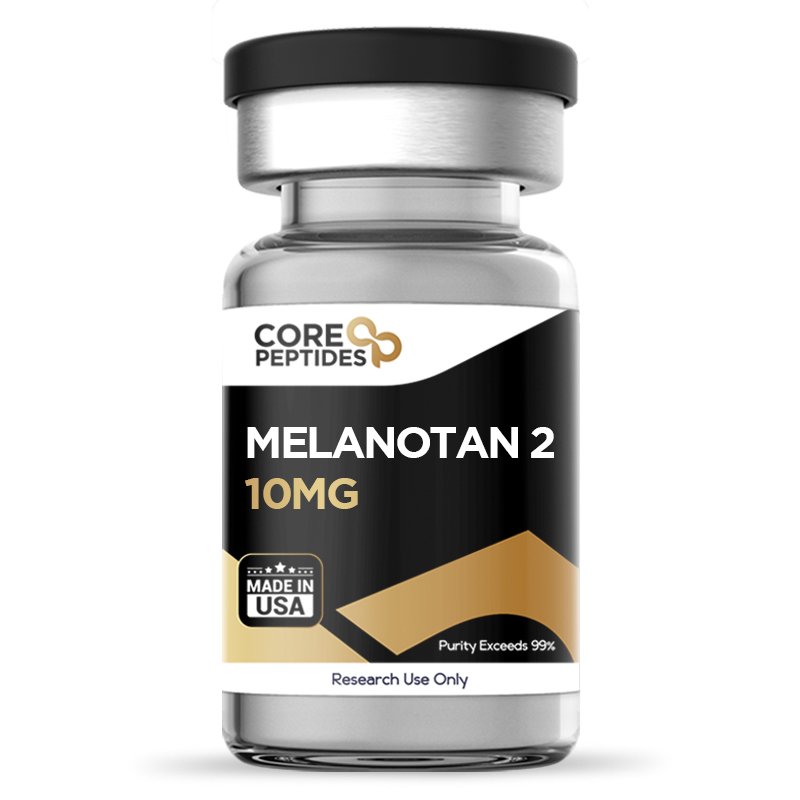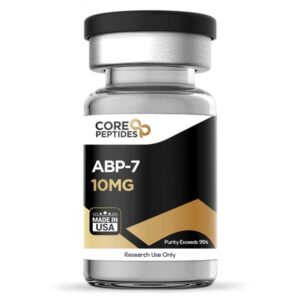Description
Melanotan 2 (MT-II) Peptide — Research Overview
Melanotan 2 (MT-II) is a synthetic cyclic heptapeptide analog of α-melanocyte-stimulating hormone (α-MSH), designed to investigate melanocortin receptor activation and its downstream effects. This research peptide demonstrates a modified affinity for several melanocortin receptor subtypes (MC1R, MC3R, MC4R, MC5R), potentially regulating pigmentation, appetite, sexual function, and neuronal signaling pathways.
MT-II’s unique cyclic structure supports enhanced receptor stability and prolonged activity, making it a valuable tool for preclinical studies of pigmentation, neuromodulation, and neuroprotective mechanisms.
Chemical Profile
-
Other Names: MT-II
-
Molecular Formula: C₅₀H₆₉N₁₅O₉
-
Molecular Weight: 1024.19 g/mol
-
Structure: Cyclic heptapeptide with modified amino acid residues for enhanced receptor affinity
Mechanism of Action
1. Melanocortin Receptor Binding
Melanotan 2 acts as a non-selective agonist with potential interactions at four melanocortin receptors:
-
MC1R (Melanocytes): Stimulates eumelanin synthesis, potentially increasing skin pigmentation and enabling sunless tanning models.
-
MC3R (Brain, Placenta): May modulate energy balance and appetite regulation.
-
MC4R (Hypothalamus): Engages central pathways related to sexual arousal and libido.
-
MC5R (Peripheral tissues): Exact roles remain under investigation; may influence peripheral glandular activity.
2. Neuromodulation and Neuroprotection
-
MT-II may promote neurite outgrowth and nerve regeneration in preclinical models of peripheral nerve injury, possibly via MC4R-mediated intracellular signaling.
-
Potential neuroprotective effects have been observed in models exposed to neurotoxic agents, suggesting MT-II may support intrinsic recovery mechanisms in damaged neuronal tissues.
3. Arousal and Behavioral Modulation
-
Clinical observations suggest that MT-II can enhance arousal neuron signaling, possibly through MC4R and downstream dopaminergic and oxytocinergic pathways in hypothalamic centers.
-
It may influence social cognition and neurodevelopmental circuits, modulating oxytocin release and affecting serotonin, glutamate, dopamine, and GABA neurotransmission, which could theoretically recalibrate neurochemical balance in specific experimental contexts.
Research Applications
Melanotan 2 has been employed in multiple experimental areas, including:
-
Sunless Tanning Models: Investigating increased eumelanin production in melanocytes without ultraviolet exposure.
-
Neuroprotection and Nerve Regeneration: Studying recovery after peripheral nerve injury and mitigating chemotherapy-induced neurotoxicity.
-
Arousal and Sexual Behavior: Assessing MC4R-mediated modulation of libido and central nervous system signaling.
-
Neurodevelopmental Research: Exploring potential effects on oxytocinergic signaling, synaptic plasticity, and cortical-subcortical network connectivity.
-
Metabolic and Appetite Studies: Examining potential MC3R-mediated influences on energy homeostasis and appetite regulation.
Key Observations from Research
-
MT-II has demonstrated enhanced pigmentation, particularly in the face, upper body, and skin regions rich in melanocytes.
-
Evidence suggests MT-II may stimulate neuronal recovery in murine models and protect against neurotoxic agents such as cisplatin.
-
Clinical and preclinical research indicates that MT-II may increase arousal and sexual signaling in a significant proportion of subjects compared to placebo.
-
The peptide’s cyclic structure and receptor binding profile provide a prolonged and potent activity window relative to natural α-MSH analogs.
Safety and Laboratory Use
Melanotan 2 is intended exclusively for laboratory and research purposes. It is not approved for human use or therapeutic applications. Researchers should strictly adhere to safety protocols and laboratory guidelines when handling this compound.
References
-
Ryakhovsky, V. V., et al. The first preparative solution phase synthesis of Melanotan II. Beilstein J Org Chem. 2008;4:39. doi:10.3762/bjoc.4.39
-
Hadley, M. E. Discovery that a melanocortin regulates sexual functions in male and female humans. Peptides. 2005;26(10):1687–1689.
-
King, S. H., et al. Melanocortin receptors, melanotropic peptides and penile erection. Curr Top Med Chem. 2007;7(11):1098–1106.
-
Peters, B., et al. Melanotan II: a possible cause of renal infarction: review of the literature and case report. CEN Case Rep. 2020;9(2):159–161.
-
Mac E. Hadley, Melanocortin receptor activation and neuronal signaling pathways. Peptides. 2005;26:1687–1689.
-
King, S. H., et al. MC receptor modulation and sexual function. Curr Top Med Chem. 2007;7:1098–1106.
-
Peters, B., et al. MT-II and neuroprotection in peripheral nerve models. CEN Case Rep. 2020;9:159–161.
-
Ryakhovsky, V. V., et al. Melanogenesis and receptor-mediated skin pigmentation. Beilstein J Org Chem. 2008;4:39.





Reviews
There are no reviews yet.